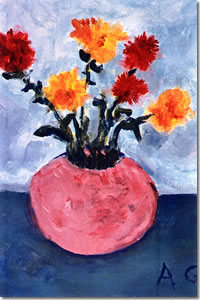 Examples of Therapeutic Art
Examples of Therapeutic Art
“Yellow, Yellow, Catch a Fellow”
“Anne,” a 91-year-old woman diagnosed with dementia, created this exuberant acrylic painting. Her joy and sense of humor are apparent in this acrylic painting.
Shortly after her death I received a card with a reproduction of her painting, “Yellow, Yellow Catch a Fellow.” Her daughter sent a similar card to family and friends in memory of her mother. The art therapy sessions that she gave her mother those last few months were truly a gift for all three of us—for Anne, her daughter, and most certainly for me.
I dedicate my work with older adults to Anne who confirmed for me once again the importance of art and the creative process in contributing to the quality of life as we age.
Veil Painting
Watercolor is one of the preferred mediums for use for patients with Parkinson's Disease. Learn more about Dr. Bagan's veil-painting from her studies in Colorado.
Other examples of art
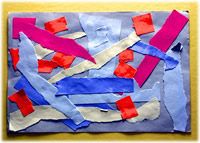 "A scattered, shattered life"
"A scattered, shattered life"
"Sam," a patient recently diagnosed with Parkinson's Disease, created this piece of art with torn pieces of construction paper. He said, "This is my life. This is how I am now." He titled it "A scattered, shattered life." Before he made this collage he refused to talk about how he felt. When he finally shared his feelings in the group, others were able to relate to him, share their feelings, and offer support to him. Working with collage provides an excellent medium for Parkinson patients. See a larger version of this work
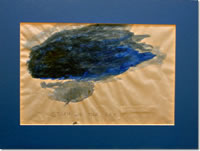 "Storm in the Sky"
"Storm in the Sky"
In her first art therapy group session at the nursing home, "Alice" completed this watercolor picture. When asked to comment about it she said, "Since I came here it seems like there is a big dark cloud hanging over me, following me wherever I go, and a big storm is brewing." See a larger version of this work »
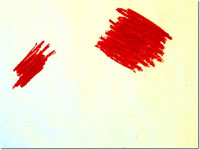 "I feel like screaming."
"I feel like screaming."
This simple drawing was done by an 80 year old woman who usually sat quietly in the group session and did not participate. I always placed a piece of paper and some colors in front of her on the table. One day she picked up a red oil pastel and made this drawing. When I asked her if she wanted to say something about her drawing she said, "I feel like screaming." This was the first time she was able to express how she felt. See a larger version of this work »
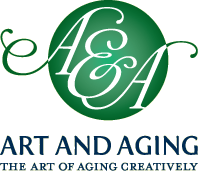 Barbara Bagan, Ph.D., ATR-BC
Barbara Bagan, Ph.D., ATR-BC